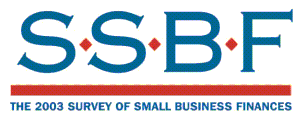
Small businesses play an important role in the U.S. economy, accounting for more than 50% of non-farm private gross domestic product and employing half of America's private work force. In fact, small businesses represent 99.7% of all employers in the United States!
In recognition of the importance of small businesses, the U.S. Congress passed Section 2227 of the Economic Growth and Regulatory Paperwork Reduction Act of 1996, which is intended to encourage depository institutions to help meet the credit needs of the communities they serve. To meet the reporting requirements of this Act, the Board of Governors of the Federal Reserve System sponsors the Survey of Small Business Finances. The survey asks small business owners about experiences with credit, use of financial services, income and balance sheet information, and their opinions on the most important problem facing their business today.
This brochure presents selected results from the 1998 survey as ezamples of what we hope to learn about small businesses in 2003. This new information will show the effect of changes in the business environment since 1998 on all types of small businesses.
The percent of small businesses...
in services 43%
in retail 19%
in manufacturing 8%
that had fewer than 10 employees 83%
The percent of firms with only one employee
that had less than $50,000 in sales 58%
The percent of proprietorships
that had less than $50,000 in sales 42%
Quality of labor 12.6%
Competition 11.3%
Poor Sales 7.5%
Taxes 6.9%
Financing and interest rates 6.8%
Government regulations/red tape 6.8%
The percent of small businesses...
that used a credit card for business purposes 68%
that said they hadn't applied for credit because they
feared the application would be turned down 23%
that used trade credit (credit from suppliers) 62%
that had loans, lines of credit, or leases 55%
Of those firms, the percent that had loans, lines of credit or leases...
with commercial banks 70%
with finance companies 25%
at leasing companies 12%
with individuals 11%
with government agencies (i.e. SBA) 2%
Average % interest on most recent loan 9.4%
When the survey was conducted in 1998, the economy was booming and financial institutions competed for business by offering attractive rates and a wide selection of services. Small business owners reported finding good quality labor and dealing with competition as the most important problems facing their businesses.
However, by 2003, the climate for small businesses had changed. The economy was in its third consecutive year of slow growth following a recession. Added to the general slowdown was the devastating impact of the September 11 attacks and continued fears of terrorism. Many small businesses failed while surviving businesses faced declining revenue. Health care costs increased sharply, venture capital opportunities declined, and banks instituted new fees and raised existing fees and balance requirements.
On the other hand, interest rates were lower than they had been in decades, allowing for cheaper loans and substantial savings from refinancing existing loans. Congress lowered personal income tax rates and increased the small business expensing limit.
Rapid technological change and consolidation in the banking industry have also affected the economic environment for small businesses.
The Survey of Small Business Finances is an essential tool for understanding the impact of these changes in the business environment. The Federal Reserve Board's report will inform legislation that will help small businesses adapt to this rapidly changing environment by ensuring the continuing availability of credit to all types of small businesses.
The small business community in America is a mosaic of many different types of companies. Every part of the mosaic needs to be represented in this survey in order to give Congress a complete picture of the economic health of small businesses in our country today.
By providing a snapshot of the status of small businesses as of 2003, policymakers will be able to understand how changes in the business climate and the financial industry have affected small businesses since 1998 and ensure that financial institutions are meeting the credit needs of small businesses in the communities they serve.

The percent of small businesses...
that conducted all of their financial business
with only one financial institution 42%
that are 10 miles or less from their
primary financial source 85%
The percent of small businesses...
that had majority ownership held by women 24%
that were co-owned equally by men and women 4%
that were minority owned 15%
that were owned by Hispanics 6%
that were owned by African Americans 4%
that were owned by Asians or
Pacific Islanders 4%
that use computers 76%
About NORC
The National Opinion Research Center at the University of Chicago is conducting the 2003 Survey of Small Business Finances.
NORC . . .
Is one of the nation's most respected survey organizations.
Has conducted survey research on public policy issues for more than 55 years.
Is a not-for-profit group whose primary focus is social science research in the public interest.
Employs interviewers who are carefully trained professionals. They contact people throughout the United States on studies�like this one�concerned with vital national issues.
